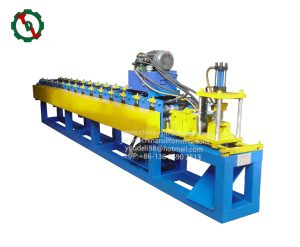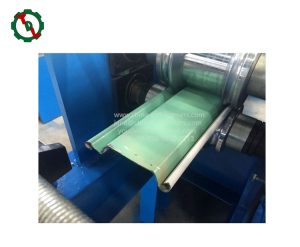I. Introduction
Rolling shutter roll forming machines are specialized equipment used in the manufacturing process of rolling shutters, which are commonly found in commercial and industrial buildings, garages, and shops. These machines play a crucial role in shaping and forming the metal strips that make up the rolling shutters, ensuring precision and consistency in the final product.
Choosing the right one is essential for achieving optimal performance and quality in the production process. Factors such as the machine’s speed, accuracy, and flexibility in handling different materials and profiles are key considerations. Additionally, the durability and reliability of the machine are important to minimize downtime and maintenance costs. Proper selection of a rolling shutter roll forming machine can significantly impact the efficiency and profitability of a manufacturing operation.

II. Key Features to Consider
- Material Compatibility: When selecting a rolling shutter roll forming machine, it’s crucial to ensure that the machine is compatible with the specific material of the rolling shutter. Different materials, such as aluminum, steel, or PVC, require different machine specifications to ensure proper forming and quality of the final product. The machine should be able to handle the thickness and width of the material effectively to avoid any issues during the forming process.
- Rolling Shutter Design: The design of the rolling shutter can also impact the choice of roll forming machine. Different designs, such as single-slat, double-slat, or perforated slats, require specific machine configurations to achieve the desired shape and functionality. Considerations include the profile shape, rib height, and spacing, as well as any additional features like insulation or locking mechanisms. Choosing a machine that can accommodate the desired design is essential for achieving the desired end product.
- Production Capacity: The production capacity of the roll forming machine is another important factor to consider. The machine should be able to meet your production needs efficiently without causing delays or compromising on quality. Factors to consider include the speed of the machine, the number of forming stations, and the overall output capacity. It’s essential to choose a machine that can handle your expected production volume to ensure smooth operations and timely delivery of the rolling shutters.
- Automation and Control: Automation and advanced control systems can significantly enhance the efficiency of a rolling shutter roll forming machine. Automated systems can streamline the forming process, reduce manual labor, and minimize the risk of errors. Advanced control systems allow for precise adjustments to be made to the machine settings, ensuring consistent quality and performance. When choosing a roll forming machine, consider the level of automation and control features it offers to maximize efficiency and productivity.
- Durability and Maintenance: The durability and ease of maintenance of the roll forming machine are critical considerations for long-term performance. A machine made from high-quality materials and components is likely to be more durable and require less frequent maintenance. Look for features such as robust construction, easy access for maintenance, and reliable components. A machine that is easy to maintain will minimize downtime and ensure consistent performance over time.
III. Factors Influencing Machine Selection
- Budget Constraints:
- The budget available for purchasing a rolling shutter roll forming machine can significantly influence the choice. Higher budgets may allow for machines with more advanced features or higher production capacities, while tighter budgets may require prioritizing essential functions.
- Manufacturer Reputation:
- The reputation of the manufacturer is crucial when selecting a roll forming machine. A reputable manufacturer is more likely to produce high-quality machines that are reliable and durable, reducing the risk of breakdowns and maintenance issues.
- Space and Installation Requirements:
- Considerations for the space available for the machine and its installation process are essential. The size and layout of your facility will determine the type and size of machine that can be accommodated, as well as the ease of installation and future maintenance access.

IV. Case Studies or Examples
- Commercial Building Project: In a recent commercial building project, the selection of a high-capacity rolling shutter roll forming machine significantly improved efficiency. The machine’s ability to handle large volumes of materials allowed for faster production, leading to timely completion of the project. Additionally, the durability of the machine ensured that the rolling shutters met quality standards, enhancing the overall security and aesthetics of the building.
- Residential Renovation: A homeowner chose a compact and versatile rolling shutter roll forming machine for a residential renovation project. The machine’s small footprint and easy setup were ideal for the limited space available. Despite its size, the machine delivered high-quality rolling shutters that enhanced the home’s security and energy efficiency. The homeowner noted that choosing the right machine saved time and money, as it required minimal maintenance and produced minimal waste.
- Industrial Warehouse Upgrade: An industrial warehouse underwent an upgrade that included the installation of rolling shutters for improved security and temperature control. The selection of a rolling shutter roll forming machine with advanced automation and control features proved instrumental in achieving the project goals. The machine’s ability to produce precise and consistent profiles ensured a perfect fit for the shutters, enhancing their functionality and durability in the industrial setting.
- Retail Storefront Installation: A retail store opted for custom-designed rolling shutters to enhance its storefront’s security and visual appeal. The choice of a rolling shutter roll forming machine capable of producing intricate designs and patterns allowed for the creation of eye-catching shutters that reflected the store’s branding. The machine’s flexibility and precision in forming the shutters contributed to a seamless installation process, minimizing disruptions to the store’s operations.
These case studies demonstrate the importance of choosing the right rolling shutter roll forming machine for specific projects. The examples highlight how the selection of a machine tailored to the project’s requirements can lead to improved efficiency, quality, and overall success. By investing in the right machine, businesses and homeowners can achieve their desired outcomes while maximizing the benefits of rolling shutters.
V. Conclusion
Selecting the right rolling shutter roll forming machine is crucial for ensuring optimal performance and efficiency in your shutter manufacturing process. To recap, it’s essential to consider several key factors. Firstly, material compatibility is paramount; ensure the machine can handle the specific material and thickness of your rolling shutters. Secondly, consider the design of the rolling shutters you intend to produce, as different designs may require specific machine capabilities. Thirdly, production capacity is crucial; choose a machine that can meet your production requirements.
Moreover, automation and control features can greatly enhance efficiency and productivity. Look for machines with advanced automation options and user-friendly controls. Additionally, durability and maintenance should not be overlooked; a durable machine with easy maintenance requirements can save you time and money in the long run.
In conclusion, investing time in research and carefully considering your budget and space requirements are crucial steps in choosing the right one. By following these guidelines and perhaps looking at case studies or examples of successful machine selection, you can ensure that your investment in a rolling shutter roll forming machine is well-informed and leads to optimal outcomes for your manufacturing process.






